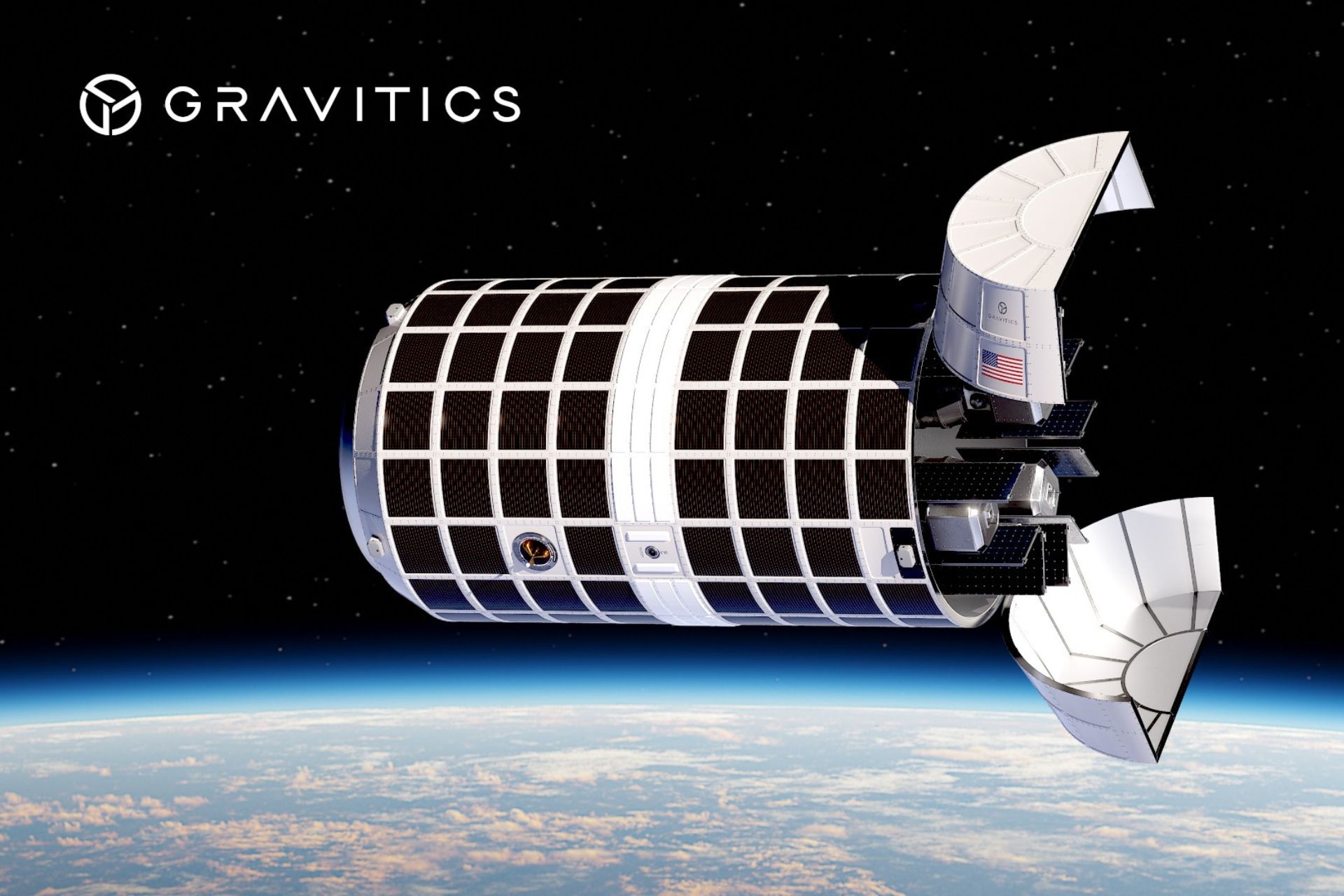US Space Force and Gravitics to Develop Space-Based Aircraft Carrier in Response to Sino-Russian Strategic Threats

{loadposition bannertop}
{loadposition sidebarpub}
The orbital aircraft carrier project led by the American company Gravitics marks a strategic shift in the race for space supremacy. Backed by a STRATFI contract worth up to $60 million, awarded by the US Space Force through its innovation office SpaceWERX, the program aims to demonstrate by 2026 the ability to pre-position and rapidly deploy satellites directly from Earth’s orbit. Described as the space equivalent of a naval aircraft carrier, this technology is intended to transform orbital operations by providing armed forces with rapid and autonomous tactical response capabilities.
Follow Army Recognition on Google News at this link
The first, smaller-scale version is expected to launch as early as next year, followed by a more ambitious iteration with an internal volume of 60 cubic meters and a launch mass ranging between 5,000 and 10,000 kg (Picture source: Gravitics)
Gravitics, a Seattle-based startup specializing in space infrastructure, was selected to develop the prototype of this concept known as the “Orbital Carrier.” The first, smaller-scale version is expected to launch as early as next year, followed by a more ambitious iteration with an internal volume of 60 cubic meters and a launch mass ranging between 5,000 and 10,000 kg. The design consists of a cylindrical module wrapped in solar panels, engineered to open in orbit and provide a non-pressurized compartment capable of housing and releasing several satellites based on operational needs.
This project diverges from previous approaches favored by the Department of Defense, which focused on rapid terrestrial launches to replace disabled satellites. The Orbital Carrier instead adopts a preemptive posture by placing deployment platforms already in orbit near strategic zones, thereby drastically reducing reaction time in the event of a threat or loss of capacity. According to Gravitics CEO Colin Doughan, the system mirrors naval logic: “Aircraft carriers allow the military to have assets on standby close to areas of interest. Our Orbital Carriers do the same, but in space.”
The current American space doctrine increasingly relies on autonomous, reactive, and protected systems. The Orbital Carrier is designed to transport multiple maneuverable spacecraft that can be activated in response to electronic warfare, laser blinding, or deliberate jamming of critical satellites. In a practical scenario, a satellite stored inside the platform could be rapidly deployed to obstruct a hostile line-of-sight or quickly restore lost strategic capabilities.
This strategic shift aligns with a broader context of growing technological competition. General Chance Saltzman, Chief of Space Operations for the US Space Force, recently emphasized that achieving space superiority has become a national priority. At the AFA Warfare Symposium in March 2025, he stated that the United States still lacked the necessary orbital service to secure such superiority. The Orbital Carrier program is therefore seen as a critical asset to bridge this gap, particularly in light of enhanced Chinese and Russian space capabilities, which include neutralization systems and simulated space combat exercises.
These rising tensions in orbit have led to the creation of specialized Space Force units focused on counter-satellite operations, electronic warfare, and orbital defense tactics. One notable example is the “Victox Nox” mission conducted by Firefly Aerospace in late 2023, which launched a payload within just 27 hours of receiving the order. While this illustrates a significant step in rapid response, the Orbital Carrier aims to go further by eliminating the need for ground-based launches, allowing more discreet and unpredictable space operations.
Alongside its military activities, Gravitics is continuing to expand in the commercial space sector. The company has signed a $125 million contract with Axiom Space to deliver a pressurized module for Axiom’s future commercial space station. This dual engagement highlights the emergence of an American space ecosystem built around synergies between commercial innovation and strategic defense requirements. According to Gravitics, the technologies developed for the Orbital Carrier will be directly transferable to civilian orbital habitat projects, reinforcing public-private cooperation in the space domain.
The geopolitical context surrounding this innovation further enhances its strategic significance. The United States has accused China of building a “kill mesh” in orbit—an array of anti-satellite systems designed to disrupt or neutralize adversary space assets. In response, the United States is seeking not only to secure its existing satellite infrastructure but also to develop mobile, modular, and responsive platforms capable of ensuring the continuity and resilience of its low-Earth orbit constellations.
The implementation of the Orbital Carrier project thus represents a key step in the evolution of US space doctrine. It reflects a determined effort to equip the Space Force with systems suited to an environment increasingly perceived as a contested operational domain—where speed, foresight, and logistical independence are becoming critical factors. If fully operational by 2026, the Orbital Carrier could significantly reshape the strategic model for power projection beyond Earth’s atmosphere while raising pressing issues around regulation, transparency, and international stability.
On the legal front, space militarization remains primarily governed by the 1967 Outer Space Treaty, which prohibits the placement of nuclear or other weapons of mass destruction in orbit and reserves space for peaceful purposes. However, the treaty does not explicitly forbid non-aggressive military activities or the deployment of conventional weapons in space, leaving room for interpretation that some states have used to develop denial and projection capabilities. Other international instruments, such as UN resolutions on the Prevention of an Arms Race in Outer Space (PAROS), remain non-binding due to the lack of consensus among major space powers, particularly the United States, China, and Russia.
The implications of this militarization are considerable. Space has become a vital operational environment for communication, navigation, strategic surveillance, and nuclear deterrence. Military satellites, now essential to defense infrastructure, have become prime targets in the event of conflict due to their vulnerability to jamming, cyberattacks, or kinetic strikes. This growing dependency carries the risk of escalation, especially as national space doctrines evolve toward more assertive postures. Finally, the emergence of technologies such as orbital deployment platforms and interceptors underscores the urgent need for a credible multilateral framework to prevent space from becoming a permanently contested and conflict-prone domain.

{loadposition bannertop}
{loadposition sidebarpub}
The orbital aircraft carrier project led by the American company Gravitics marks a strategic shift in the race for space supremacy. Backed by a STRATFI contract worth up to $60 million, awarded by the US Space Force through its innovation office SpaceWERX, the program aims to demonstrate by 2026 the ability to pre-position and rapidly deploy satellites directly from Earth’s orbit. Described as the space equivalent of a naval aircraft carrier, this technology is intended to transform orbital operations by providing armed forces with rapid and autonomous tactical response capabilities.
The first, smaller-scale version is expected to launch as early as next year, followed by a more ambitious iteration with an internal volume of 60 cubic meters and a launch mass ranging between 5,000 and 10,000 kg (Picture source: Gravitics)
Gravitics, a Seattle-based startup specializing in space infrastructure, was selected to develop the prototype of this concept known as the “Orbital Carrier.” The first, smaller-scale version is expected to launch as early as next year, followed by a more ambitious iteration with an internal volume of 60 cubic meters and a launch mass ranging between 5,000 and 10,000 kg. The design consists of a cylindrical module wrapped in solar panels, engineered to open in orbit and provide a non-pressurized compartment capable of housing and releasing several satellites based on operational needs.
This project diverges from previous approaches favored by the Department of Defense, which focused on rapid terrestrial launches to replace disabled satellites. The Orbital Carrier instead adopts a preemptive posture by placing deployment platforms already in orbit near strategic zones, thereby drastically reducing reaction time in the event of a threat or loss of capacity. According to Gravitics CEO Colin Doughan, the system mirrors naval logic: “Aircraft carriers allow the military to have assets on standby close to areas of interest. Our Orbital Carriers do the same, but in space.”
The current American space doctrine increasingly relies on autonomous, reactive, and protected systems. The Orbital Carrier is designed to transport multiple maneuverable spacecraft that can be activated in response to electronic warfare, laser blinding, or deliberate jamming of critical satellites. In a practical scenario, a satellite stored inside the platform could be rapidly deployed to obstruct a hostile line-of-sight or quickly restore lost strategic capabilities.
This strategic shift aligns with a broader context of growing technological competition. General Chance Saltzman, Chief of Space Operations for the US Space Force, recently emphasized that achieving space superiority has become a national priority. At the AFA Warfare Symposium in March 2025, he stated that the United States still lacked the necessary orbital service to secure such superiority. The Orbital Carrier program is therefore seen as a critical asset to bridge this gap, particularly in light of enhanced Chinese and Russian space capabilities, which include neutralization systems and simulated space combat exercises.
These rising tensions in orbit have led to the creation of specialized Space Force units focused on counter-satellite operations, electronic warfare, and orbital defense tactics. One notable example is the “Victox Nox” mission conducted by Firefly Aerospace in late 2023, which launched a payload within just 27 hours of receiving the order. While this illustrates a significant step in rapid response, the Orbital Carrier aims to go further by eliminating the need for ground-based launches, allowing more discreet and unpredictable space operations.
Alongside its military activities, Gravitics is continuing to expand in the commercial space sector. The company has signed a $125 million contract with Axiom Space to deliver a pressurized module for Axiom’s future commercial space station. This dual engagement highlights the emergence of an American space ecosystem built around synergies between commercial innovation and strategic defense requirements. According to Gravitics, the technologies developed for the Orbital Carrier will be directly transferable to civilian orbital habitat projects, reinforcing public-private cooperation in the space domain.
The geopolitical context surrounding this innovation further enhances its strategic significance. The United States has accused China of building a “kill mesh” in orbit—an array of anti-satellite systems designed to disrupt or neutralize adversary space assets. In response, the United States is seeking not only to secure its existing satellite infrastructure but also to develop mobile, modular, and responsive platforms capable of ensuring the continuity and resilience of its low-Earth orbit constellations.
The implementation of the Orbital Carrier project thus represents a key step in the evolution of US space doctrine. It reflects a determined effort to equip the Space Force with systems suited to an environment increasingly perceived as a contested operational domain—where speed, foresight, and logistical independence are becoming critical factors. If fully operational by 2026, the Orbital Carrier could significantly reshape the strategic model for power projection beyond Earth’s atmosphere while raising pressing issues around regulation, transparency, and international stability.
On the legal front, space militarization remains primarily governed by the 1967 Outer Space Treaty, which prohibits the placement of nuclear or other weapons of mass destruction in orbit and reserves space for peaceful purposes. However, the treaty does not explicitly forbid non-aggressive military activities or the deployment of conventional weapons in space, leaving room for interpretation that some states have used to develop denial and projection capabilities. Other international instruments, such as UN resolutions on the Prevention of an Arms Race in Outer Space (PAROS), remain non-binding due to the lack of consensus among major space powers, particularly the United States, China, and Russia.
The implications of this militarization are considerable. Space has become a vital operational environment for communication, navigation, strategic surveillance, and nuclear deterrence. Military satellites, now essential to defense infrastructure, have become prime targets in the event of conflict due to their vulnerability to jamming, cyberattacks, or kinetic strikes. This growing dependency carries the risk of escalation, especially as national space doctrines evolve toward more assertive postures. Finally, the emergence of technologies such as orbital deployment platforms and interceptors underscores the urgent need for a credible multilateral framework to prevent space from becoming a permanently contested and conflict-prone domain.





